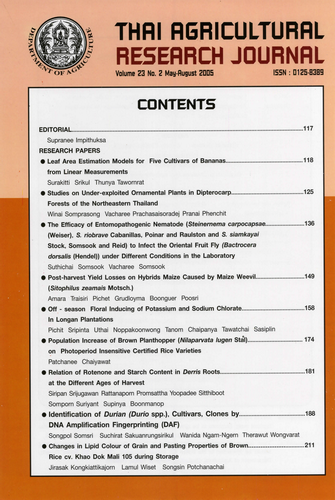The Efficacy of Entomopathogenic Nematode (Steinernema carpocapsae (Weiser), S. riobrave Cabanillas, Poinar and Raulston and S. siamkayai Stock, Somsook and Reid) to Infect the Oriental Fruit Fly (Bactrocera dorsalis (Hendel)) under Different Conditions in the Laboratory
DOI:
https://doi.org/10.14456/thaidoa-agres.2005.12Keywords:
maize, maize weevil, Sitophilus zeamais Motsch, Store producrt insect, yield loss Steinernema carpocapsae (Weiser), Steinernema riobrave Cabanilas, Poinar and Raulston, Steinernema siamkayai Stock, Soomsook and Rie, oreintal fruit (Bactrocera dorsalis (Hendel))Abstract
The efficacy of the three entomopathogenic nematode species nanely Steinernema carpocapsae, S. riobrave and S. siamkayai against oriental fruit fly (Bactrocera dorsalis (Handel)) was conducted in 3 experiments at the laboratory of Department of Agriculture during October 2003 – September 2004. The first experiment was designed in CRD with 3 replications and 12 treatments resulting from the combination between 3 nematode species and 4 nematode suspension concentration rates used at 200, 400, 800 and 1600 lJs/ml/cup. The second experiment was conducted separately in 3 subtests according to 3 different temperatures at 25, 30 and 35˚C, Each subtest was arranged in CRD with 3 replications and 3 treatments including three nematode species. A combined analysis was introduced to resolve the interaction between the nematode species and temperatures. The third experiment was designed as 3 x 3 Factorial in CRD with 3 replications. The factor A was the nematode species namely S. carpocapsae, S. riobrave and S. siamkayai and the factor B was three growth stages of oriental fruit fly consisting of 5 and 9 day-old larvae or early and late 3ᴿᵈ instars (prepupae)) and 11 day-old pupae. The early third larval instars were used in the experiment 1 and 2, the dosage for the trial 2 and 3 conducted at 25 ˚C was 800 lJs/ml/cup. Each replication for all tests contained 5 larvae or pupae. Three days after exposure, the result showed that at the increasing concentrations of 200 and 400 lJs/ml/cup S. carpocapsae, S. riobrave and S. siamkayai caused significantly higher mortality from 20.0-53.3 to 33.3-86.7 %, at the most effective dosages used (800 and 1600 lJs/ml/cup) S. carpocapsae (82.2-86.7%) and S. riobrave (71.1-80.0%) exhibited significantly higher efficacy than S. siamkayai (33.3-40.2%) At 25 and 30˚C S. carpocapsae caused high mortalith rates (86.7 and 84.5%) to the early third instars of fruit fly larvae whereas significantly decreased at 35˚C to 8.9% At 30 and 35 ˚C S. riobrave showed 84.5 percent of mortality which decreased insignificantly at 25˚C to 75.6 % and S. siamkayai gave significantly defferent mortality at 30˚C at 35.6% and 35˚C at 22.2%. Every temperature level S. siamkayai had significantly less mortality rates than the first two species. The effectiveness of the three nematode species against pupae of fruit fly was very low (0-6.7%) while the larval stages were significantly more susceptible. The mortality percentages of early and late 3rd instars caused by S. carpocapsae were 86.7 and 80.0% respectively, being significantly higher than those caused by S. riobrave were 75.6 and 62.2, respectively, whereas S. siankayai gave the significantly least mortality with 22.2% for larvae and 8.9% fir oreoyoae.
Downloads
Published
How to Cite
Issue
Section
License

This work is licensed under a Creative Commons Attribution-NonCommercial-NoDerivatives 4.0 International License.
Thai Agricultural Research Journal



